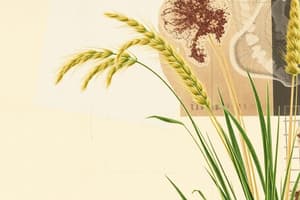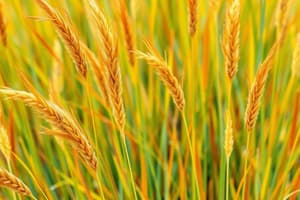Podcast
Questions and Answers
Which plant family does Eragrostis tef belong to?
Which plant family does Eragrostis tef belong to?
- Fabaceae
- Poaceae (correct)
- Asteraceae
- Brassicaceae
What type of plant is Eragrostis tef?
What type of plant is Eragrostis tef?
- Shrub perennial
- Herbaceous biennial
- Herbaceous annual (correct)
- Woody perennial
Where was Eragrostis tef first domesticated?
Where was Eragrostis tef first domesticated?
- North Africa
- North America
- Ethiopia (correct)
- Southeast Asia
What part of Eragrostis tef is primarily used for food?
What part of Eragrostis tef is primarily used for food?
Which region is Eragrostis tef most widely grown in?
Which region is Eragrostis tef most widely grown in?
What part of Eruca vesicaria is utilized for food?
What part of Eruca vesicaria is utilized for food?
Which preparation method is commonly used for Eruca vesicaria before consumption?
Which preparation method is commonly used for Eruca vesicaria before consumption?
What is the native distribution of Eruca vesicaria?
What is the native distribution of Eruca vesicaria?
What type of root system is characteristic of monocots?
What type of root system is characteristic of monocots?
Which floral part arrangement is typical for eudicots?
Which floral part arrangement is typical for eudicots?
What is a defining morphological feature of eudicot leaves?
What is a defining morphological feature of eudicot leaves?
Which of the following plant families is NOT listed under the magnoliid group?
Which of the following plant families is NOT listed under the magnoliid group?
Which characteristic is true for all monocots?
Which characteristic is true for all monocots?
What does the biological species concept primarily rely on to define a species?
What does the biological species concept primarily rely on to define a species?
Which of the following factors can affect the morphology of plants?
Which of the following factors can affect the morphology of plants?
What is emphasized in phenetic classification systems for plants?
What is emphasized in phenetic classification systems for plants?
Which of the following is a challenge for applying the biological species concept to plants?
Which of the following is a challenge for applying the biological species concept to plants?
What has greatly advanced our understanding of phylogenetic relationships in plants?
What has greatly advanced our understanding of phylogenetic relationships in plants?
Which theory about flowering plants does the Hooker system support?
Which theory about flowering plants does the Hooker system support?
What characterizes monocotyledons in plant classification?
What characterizes monocotyledons in plant classification?
What is a commonly accepted number of flowering plant families recognized today?
What is a commonly accepted number of flowering plant families recognized today?
What type of characters are favored in phylogenetic classifications compared to phenetic classifications?
What type of characters are favored in phylogenetic classifications compared to phenetic classifications?
Which of the following is true regarding the term 'agamospermy' in plants?
Which of the following is true regarding the term 'agamospermy' in plants?
What is the significance of the floral structure in plant classification?
What is the significance of the floral structure in plant classification?
Which characteristic is NOT generally considered conservative in floral structures?
Which characteristic is NOT generally considered conservative in floral structures?
Which aspect is critical for phylogenetic classification of flowering plants according to the content?
Which aspect is critical for phylogenetic classification of flowering plants according to the content?
Which of the following are flowering plants mainly classified by?
Which of the following are flowering plants mainly classified by?
What was the primary focus of early classification systems before the development of a standardized nomenclature?
What was the primary focus of early classification systems before the development of a standardized nomenclature?
Who created the first plant classification system that distinguished natural plant groups?
Who created the first plant classification system that distinguished natural plant groups?
What is the primary disadvantage of using common names in plant nomenclature?
What is the primary disadvantage of using common names in plant nomenclature?
Which of the following describes the binomial nomenclature system introduced by Carl Linnaeus?
Which of the following describes the binomial nomenclature system introduced by Carl Linnaeus?
What is a feature of the binomial naming system regarding capitalization?
What is a feature of the binomial naming system regarding capitalization?
What is the purpose of the International Code of Botanical Nomenclature?
What is the purpose of the International Code of Botanical Nomenclature?
What does the species name in binomial nomenclature consist of?
What does the species name in binomial nomenclature consist of?
What issue arose in the Age of Herbals as a result of using common names for plants?
What issue arose in the Age of Herbals as a result of using common names for plants?
Flashcards are hidden until you start studying
Study Notes
Botanical Information
- Plant Family: Belongs to the Poaceae family, commonly known as the grass family.
- Plant Type:
- Herbaceous plant
- Classified as a herb
- Typically grows as an annual plant but can exhibit perennial characteristics in some regions.
- Native Distribution: Primarily native to the Horn of Africa, especially in Ethiopia and Eritrea.
History as a Food Plant
- Domestication: First domesticated in the Ethiopian highlands, where it has been cultivated for thousands of years.
- Widespread Growth: Most widely grown in Ethiopia, integral to local diets and cultural practices.
Utilization
- Plant Part Used: The seeds of the teff plant are the primary part utilized for human consumption.
- Processing Methods: Seeds are harvested, cleaned, and ground into flour, which is used to make various traditional dishes, including injera (a type of sourdough flatbread).
Botanical Information
- Plant Family: Belongs to the Poaceae family, commonly known as the grass family.
- Plant Type:
- Herbaceous plant
- Classified as a herb
- Typically grows as an annual plant but can exhibit perennial characteristics in some regions.
- Native Distribution: Primarily native to the Horn of Africa, especially in Ethiopia and Eritrea.
History as a Food Plant
- Domestication: First domesticated in the Ethiopian highlands, where it has been cultivated for thousands of years.
- Widespread Growth: Most widely grown in Ethiopia, integral to local diets and cultural practices.
Utilization
- Plant Part Used: The seeds of the teff plant are the primary part utilized for human consumption.
- Processing Methods: Seeds are harvested, cleaned, and ground into flour, which is used to make various traditional dishes, including injera (a type of sourdough flatbread).
Botanical Information
- Arugula (Eruca vesicaria) belongs to the Brassicaceae family, known for its member plants like cabbage and mustard.
- This plant is herbaceous and categorized as a herb, typically having a short lifespan.
- Native distribution spans Europe, North Africa, and parts of Asia, thriving in Mediterranean climates.
Utilization
- The leaves of the arugula plant are primarily used for food, adding a peppery flavor to dishes.
- It is commonly prepared in salads, cooked in dishes, or used as a garnish, often served fresh to retain its distinct taste.
Historical Overview of Plant Classification
- Organisms have been classified since Ancient Greek times, focusing on similarities and defining grouping criteria.
- Early classifications were artificial, emphasizing appearance and medicinal properties rather than evolutionary relationships.
- Theophrastus created the first plant classification system about 2300 years ago, recognizing families like Pea, Grass, and Mustard.
Development of Nomenclature
- The Age of Herbals (1470-1670) saw expansion due to the printing press, listing plants' medicinal uses with common names.
- Issues with common names included variability and ambiguity across languages, leading to a standardized Latin-based nomenclature system.
- Carl Linnaeus simplified naming through his binomial system introduced in Species Plantarum (1753), consisting of a genus name and species epithet.
Rules of Binomial Nomenclature
- Generic names are capitalized; species epithets are not.
- Names are italicized (or underlined) and may include an authority designation indicating the nomenclatural history.
- Short forms of generic names are used for repeated references (e.g., P. glauca).
Plant Species Concept
- Plant classification is primarily based on the biological species concept, indicating groups that can interbreed but face challenges in practical application.
- Spatial separation and variation in reproduction methods (e.g., agamospermy in dandelions) complicate interbreeding among plant species.
Morphological Classification Challenges
- Morphological classification faces issues due to genetic changes causing significant morphology shifts and environmental effects on growth.
- Plants exhibit plasticity in morphology that complicates consistent classification, influenced by factors like light exposure and water availability.
Evolutionary Relationships
- Phenetic classification utilizes many characters and emphasizes conservative traits, avoiding highly variable characteristics.
- Darwin's Origin of Species sparked interest in phylogenetic classification based on evolutionary relationships.
Theories of Flowering Plant Evolution
- Competing theories in the 19th century proposed differing views on the earliest flowering plants: Engler suggested small, wind-pollinated flowers, while Hooker argued for large flowers with numerous parts.
- Hooker's system—modified by others—remains accepted today, recognizing 300-350 flowering plant families.
Monocots vs. Eudicots
- Plant classification divides flowering plants into monocots (one cotyledon) and eudicots (two cotyledons), each with distinct features:
- Monocots: Herbaceous, floral parts in multiples of three, linear leaves, and fibrous root systems.
- Eudicots: Herbaceous or woody, floral parts in multiples of four or five, broad leaves, and persistent taproots.
Magnoliid Angiosperms
- Genetic studies indicate an additional group, magnoliid angiosperms, evolved before the divergence of monocots and eudicots.
- Key magnoliid families include:
- Magnoliaceae: Horticultural and timber species.
- Lauraceae: Includes cinnamon, avocado, and bay leaves.
- Annonaceae: Tropical fruits like soursop.
- Piperaceae: Black pepper.
- Myristicaceae: Nutmeg and other tropical timbers.
Studying That Suits You
Use AI to generate personalized quizzes and flashcards to suit your learning preferences.




